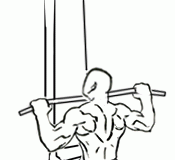Last Updated on January 27, 2024
When you go to just any GYM and take a close look at the members working out, then come back a year later, you will notice that most of them still use the same weights as during your first visit. Why? Because most bodybuilders waste their time with their usual training programs.
If the buildup of mass and muscle mass was actually connected with the general common amount of training there would be many more massive bodybuilders. Since this, however, as reality has shown, is apparently not the case a few things seem to be wrong with the typical bodybuilding program. Since most people unnecessarily create their own obstacles they tremendously complicate achieving-their goals (strength and muscle buildup).
The majority of them, at least those who are interested in the subject of this book, call them hardcore bodybuilders. Hardcore, however, does not mean training six times a week for three hours and copying Lee Haney’s training for a competition, but something completely different.
To create a sensible training plan and carry it out without compromise over a prolonged period of time is what makes a true hardcore bodybuilder because only he has the necessary willpower, discipline, ambition and perseverance that is needed. Forget endless long training routines, Mr. Olympia Superstar programs, and deceptive ads such as 30 pounds of muscles in four weeks, and think of the basics without which a strong and massive body cannot exist.
You should take the following factors to heart since they are absolutely necessary for a successful training. What role does the use of anabolic/androgenic steroids play- Very simple: athletes who take steroids will make clearly faster, better, and greater progress than their natural colleagues.
They will also obtain a much higher development stage than would have ever been possible without taking pharmaceutical compounds. Such stupid statements that one will achieve the same mass as a bodybuilder without taking steroids -it only takes longer-is nothing but a completely absurd publicity by the authorities who in their own interest conceal the truth. Read the following lines with an open-minded attitude and try to adapt this information for your own needs.
1. High-intensity training: The human organism vehemently refuses any unnecessary change since it feels best in a constant condition, a homeostasis. In order to lure it out of its passivity, several efforts and exertions must be made. The signal that the body needs in order to build up strength and muscle mass is triggered by heavy, hard, and intense training routines. These should consist of relatively few sets. Five to eight sets for large muscle groups and three to four sets for small muscle groups are completely sufficient when every set is carried out until muscle failure.
2. Training with relatively low repetitions: The body has two different types of muscle fibers: Since the muscle hypertrophy almost completely occurs in the fast-twitch white muscle fibers of type 2, a sensible bodybuilding workout must be developed in a way that these are sufficiently stimulated. For this purpose relatively few, heavy reps in the range of 6-10 are suitable.
3. Training with progressively heavier weights: In order to build up massive muscles they must be challenged and exposed to regular progressively-higher resistances. This can be achieved when the athlete continuously increases the weight during exercises. The stronger the muscles the larger their appearance. There is no mass without power. The basic exercises such as squats, bench presses, presses behind the neck, rows, barbell curls, dips, etc. are the most suitable.
4. Sufficient rest periods: The muscles are stimulated through training but only grow during their rest phase. The higher the intensity, the higher the damage of the muscle cell and the longer the resting phase. When you train with adequate intensity you simply cannot train each and every day nor should you attack a muscle twice a week. Learn to accept rest and recovery as important factors of your training success. Every day you train in the GYM should be followed by a complete off day. Bodybuilders who are interested in an optimal strength and muscle gain should train every muscle once very intensely every 7-8 days.
5. Plateau and phase training: The body can be put under maximum stress only for a limited time. If this time is exceeded, development comes to a stop and if continued the performance will regress. For this reason the intensity and extent of the training program should be changed every 12-14 weeks. The athlete should enjoy several days off training and then change to a several-week long maintenance training (plateau training).
The following training program considers all essential factors which are necessary for a quick buildup of strength and muscle mass. In combination with the nutrition tips included in this book its effectiveness can be considerably increased. Based on the high intensity it is not suitable for natural bodybuilders over a long time. This training schedule is obviously only intended as a suggestion and can be changed by every athlete to meet his individual needs, as long as the discussed principles are met.
Eight-Day Training Cycle: One day training, one day rest
(One day on, one day off)
| Day 1: Chest, biceps | Bench presses | 3 sets | 6- 8 reps | Incline bench presses | 2 sets | 6- 8 reps | Dips with added weights | 2 sets | 8-10 reps | Barbell curls | 3 sets | 6-10 reps | Dumbbell curls | 2 sets | 6-10 reps | Day 3: Thighs | Squats | 3 sets | 6-10 reps | Leg presses | 2 sets | 8-10 reps | Leg curls | 2 sets | 8-10 reps | Day 5: Shoulder, triceps | Presses behind neck | 3 sets | 6- 8 reps | Upright row | 2 sets | 8-10 reps | Side laterals | 2 sets | 8-10 reps | Lying triceps presses | 3 sets | 6-10 reps | Triceps pulley pushdown | 2 sets | 8-10 reps | Day 7: Back. calves | Chins with added weight | 3 sets | 8-10 reps | Lat pull to neck | 2 sets | 8-10 reps | Barbell bent-over row | 2 sets | 6-10 reps | Seated cable row | 2 sets | 6-10 reps | Standing calf raise | 3 sets | 8-12 reps | Seated calf raise | 2 sets | 8-12 reps | Note: Training is only on uneven days, i.e. every 2nd, 4th, 6th, and 8th day is a complete rest day. The intervals between the various sets should be 3-4 minutes. The athlete should pay attention that the exercises – as much as possible – are carried out with free weights and not on machines. Every muscle is directly trained only once every eight days. It is important that every set is carried out until muscle failure meaning that the athlete is unable to do another repetition on its own. Only in this case are the relatively few sets and especially long rest periods justified. The muscle cell must be brought in a strongly catabolic condition since only then the distinct anticatabolic effect of anabolic/androgenic steroids develops fully. The required intensity of training, however, can only be achieved when you start (after a short warmup) with the heaviest weight possible and then decrease the weight in every following set because of the losing body strength so that the desired repetitions can still be obtained. In order to avoid any misunderstandings we would like to quickly explain this principle on an example. Our athlete is able to carry out a maximum of six repetitions with 300 pounds on bench presses. | |||||||||||||||||||||||||||||||||||||||||||||||||||||||||||||||||||||||||||||
| Day 1: Chest, biceps | |||||||||||||||||||||||||||||||||||||||||||||||||||||||||||||||||||||||||||||||||||||||||||||||||||||||||||||||||||||||||||||||||||||||||||
| Bench presses | 3 sets | 6- 8 reps | |||||||||||||||||||||||||||||||||||||||||||||||||||||||||||||||||||||||||||||||||||||||||||||||||||||||||||||||||||||||||||||||||||||||||
| Incline bench presses | 2 sets | 6- 8 reps | |||||||||||||||||||||||||||||||||||||||||||||||||||||||||||||||||||||||||||||||||||||||||||||||||||||||||||||||||||||||||||||||||||||||||
| Dips with added weights | 2 sets | 8-10 reps | |||||||||||||||||||||||||||||||||||||||||||||||||||||||||||||||||||||||||||||||||||||||||||||||||||||||||||||||||||||||||||||||||||||||||
| Barbell curls | 3 sets | 6-10 reps | |||||||||||||||||||||||||||||||||||||||||||||||||||||||||||||||||||||||||||||||||||||||||||||||||||||||||||||||||||||||||||||||||||||||||
| Dumbbell curls | 2 sets | 6-10 reps | |||||||||||||||||||||||||||||||||||||||||||||||||||||||||||||||||||||||||||||||||||||||||||||||||||||||||||||||||||||||||||||||||||||||||
| Day 3: Thighs | |||||||||||||||||||||||||||||||||||||||||||||||||||||||||||||||||||||||||||||||||||||||||||||||||||||||||||||||||||||||||||||||||||||||||||
| Squats | 3 sets | 6-10 reps | |||||||||||||||||||||||||||||||||||||||||||||||||||||||||||||||||||||||||||||||||||||||||||||||||||||||||||||||||||||||||||||||||||||||||
| Leg presses | 2 sets | 8-10 reps | |||||||||||||||||||||||||||||||||||||||||||||||||||||||||||||||||||||||||||||||||||||||||||||||||||||||||||||||||||||||||||||||||||||||||
| Leg curls | 2 sets | 8-10 reps | |||||||||||||||||||||||||||||||||||||||||||||||||||||||||||||||||||||||||||||||||||||||||||||||||||||||||||||||||||||||||||||||||||||||||
| Day 5: Shoulder, triceps | |||||||||||||||||||||||||||||||||||||||||||||||||||||||||||||||||||||||||||||||||||||||||||||||||||||||||||||||||||||||||||||||||||||||||||
| Presses behind neck | 3 sets | 6- 8 reps | |||||||||||||||||||||||||||||||||||||||||||||||||||||||||||||||||||||||||||||||||||||||||||||||||||||||||||||||||||||||||||||||||||||||||
| Upright row | 2 sets | 8-10 reps | |||||||||||||||||||||||||||||||||||||||||||||||||||||||||||||||||||||||||||||||||||||||||||||||||||||||||||||||||||||||||||||||||||||||||
| Side laterals | 2 sets | 8-10 reps | |||||||||||||||||||||||||||||||||||||||||||||||||||||||||||||||||||||||||||||||||||||||||||||||||||||||||||||||||||||||||||||||||||||||||
| Lying triceps presses | 3 sets | 6-10 reps | |||||||||||||||||||||||||||||||||||||||||||||||||||||||||||||||||||||||||||||||||||||||||||||||||||||||||||||||||||||||||||||||||||||||||
| Triceps pulley pushdown | 2 sets | 8-10 reps | |||||||||||||||||||||||||||||||||||||||||||||||||||||||||||||||||||||||||||||||||||||||||||||||||||||||||||||||||||||||||||||||||||||||||
| Day 7: Back. calves | |||||||||||||||||||||||||||||||||||||||||||||||||||||||||||||||||||||||||||||||||||||||||||||||||||||||||||||||||||||||||||||||||||||||||||
| Chins with added weight | 3 sets | 8-10 reps | |||||||||||||||||||||||||||||||||||||||||||||||||||||||||||||||||||||||||||||||||||||||||||||||||||||||||||||||||||||||||||||||||||||||||
| Lat pull to neck | 2 sets | 8-10 reps | |||||||||||||||||||||||||||||||||||||||||||||||||||||||||||||||||||||||||||||||||||||||||||||||||||||||||||||||||||||||||||||||||||||||||
| Barbell bent-over row | 2 sets | 6-10 reps | |||||||||||||||||||||||||||||||||||||||||||||||||||||||||||||||||||||||||||||||||||||||||||||||||||||||||||||||||||||||||||||||||||||||||
| Seated cable row | 2 sets | 6-10 reps | |||||||||||||||||||||||||||||||||||||||||||||||||||||||||||||||||||||||||||||||||||||||||||||||||||||||||||||||||||||||||||||||||||||||||
| Standing calf raise | 3 sets | 8-12 reps | |||||||||||||||||||||||||||||||||||||||||||||||||||||||||||||||||||||||||||||||||||||||||||||||||||||||||||||||||||||||||||||||||||||||||
| Seated calf raise | 2 sets | 8-12 reps | |||||||||||||||||||||||||||||||||||||||||||||||||||||||||||||||||||||||||||||||||||||||||||||||||||||||||||||||||||||||||||||||||||||||||
| 1st warmup set: | 10 reps with | 140 pounds | 2nd warmup set: | 2 reps with | 200 pounds | 3rd warmup set: | 2 reps with | 240 pounds | 1st working set: | 6 reps with | 300 pounds | 2nd working set: | 7 reps with | 280 pounds | 3rd working set: | 7 reps with | 260 pounds | The first warmup set serves to bring blood to the muscles and joints. The second and third warmup set are an approach to the weight of the first working set. The interplay between the muscle and nerve is stimulated, meaning the athlete gets a feeling for the heavy weights without wasting strength and energy at the same time. During the following chest exercises the warmup sets are completely omitted which means that they are only necessary for the first exercise of the muscle to be trained. Do not forget, however, that during every exercise or set you should try to squeeze out an additional one or two repetitions than during the previous training in order to in-crease training weights in the following week. This continuous tire-some struggle to increase repetitions and weight is the only way to a massive body. Always remember: HEAVY WEIGHTS BUILD BIG MUSCLES. | ||||||||||||||||||
| 1st warmup set: | 10 reps with | 140 pounds | |||||||||||||||||||||||||||||||||||
| 2nd warmup set: | 2 reps with | 200 pounds | |||||||||||||||||||||||||||||||||||
| 3rd warmup set: | 2 reps with | 240 pounds | |||||||||||||||||||||||||||||||||||
| 1st working set: | 6 reps with | 300 pounds | |||||||||||||||||||||||||||||||||||
| 2nd working set: | 7 reps with | 280 pounds | |||||||||||||||||||||||||||||||||||
| 3rd working set: | 7 reps with | 260 pounds |
re-posted with permission by https://www.anabolicreview.com/







